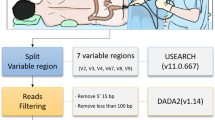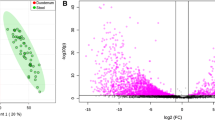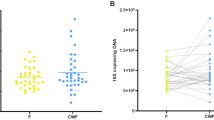Abstract
The study of the human gut microbiome is essential in microbiology and infectious diseases as specific alterations in the gut microbiome might be associated with various pathologies, such as chronic inflammatory disease, intestinal infection and colorectal cancer. To identify such dysregulations, several strategies are being used to create a repertoire of the microorganisms composing the human gut microbiome. In this study, we used the “microscomics” approach, which consists of creating an ultrastructural repertoire of all the cell-like objects composing stool samples from healthy donors using transmission electron microscopy (TEM). We used TEM to screen ultrathin sections of 8 resin-embedded stool samples. After exploring hundreds of micrographs, we managed to elaborate ultrastructural categories based on morphological criteria or features. This approach explained many inconsistencies observed with other techniques, such as metagenomics and culturomics. We highlighted the value of our culture-independent approach by comparing our microscopic images to those of cultured bacteria and those reported in the literature. This study helped to detect “minimicrobes” Candidate Phyla Radiation (CPR) for the first time in human stool samples. This “microscomics” approach is non-exhaustive but complements already existing approaches and adds important data to the puzzle of the microbiota.
Similar content being viewed by others
References
Allen, L. Geoffrey, G., and Sima, S. 2011. Advances in applied microbiology, vol. 77. Academic Press.
Angelakis, E., Bachar, D., Henrissat, B., Armougom, F., Audoly, G., Lagier, J.C., Robert, C., and Raoult, D. 2016. Glycans affect DNA extraction and induce substantial differences in gut meta-genomic studies. Sci. Rep.6, 26276.
Angelakis, E., Bibi, F., Ramasamy, D., Azhar, E.I., Jiman-Fatani, A.A., Aboushoushah, S.M., Lagier, J.C., Robert, C., Caputo, A., Yasir, M., et al. 2014. Non-contiguous finished genome sequence and description of Clostridium saudii sp. nov. Stand. Genomic Sci.9, 1–12.
Arora, H.K. and Chapman, G.B. 2000. Transmission electron microscope study of bacterial morphotypes on the anterior dorsal surface of human tongues. Anat. Rec.259, 276–287.
Auchtung, T.A., Fofanova, T.Y., Stewart, C.J., Nash, A.K., Wong, M.C., Gesell, J.R., Auchtung, J.M., Ajami, N.J., and Petrosino, J.F. 2018. Investigating colonization of the healthy adult gastrointestinal tract by fungi. mSphere3, e00092–18.
Bauer, H., Sigarlakie, E., and Faure, J.C. 1975. Scanning and transmission electron microscopy of three strains of Bifidobacterium. Can. J. Microbiol.21, 1305–1316.
Breznak, J.A. and Pankratz, H.S. 1977. In situ morphology of the gut microbiota of wood-eating termites [Reticulitermes flavipes (Kollar) and Coptotermes formosanus Shiraki]. Appl. Environ. Microbiol.33, 406–426.
Browne, H.P., Forster, S.C., Anonye, B.O., Kumar, N., Neville, B.A., Stares, M.D., Goulding, D., and Lawley, T.D. 2016. Culturing of ‘unculturable’ human microbiota reveals novel taxa and extensive sporulation. Nature533, 543–546.
Clemente, J.C., Ursell, L.K., Parfrey, L.W., and Knight, R. 2012. The impact of the gut microbiota on human health: an integrative view. Cell148, 1258–1270.
Connolly, G.M., Ellis, D.S., Williams, J.E., Tovey, G., and Gazzard, B.G. 1991. Use of electron microscopy in examination of faeces and rectal and jejunal biopsy specimens. J. Clin. Pathol.44, 313–316.
Costerton, J.W. 1979. The role of electron microscopy in the elucidation of bacterial structure and function. Annu. Rev. Microbiol.33, 459–479.
Danczak, R.E., Johnston, M.D., Kenah, C., Slattery, M., Wrighton, K.C., and Wilkins, M.J. 2017. Members of the Candidate Phyla Radiation are functionally differentiated by carbon- and nitrogen-cycling capabilities. Microbiome5, 112.
Dao, M.C., Everard, A., Aron-Wisnewsky, J., Sokolovska, N., Prifti, E., Verger, E.O., Kayser, B.D., Levenez, F., Chilloux, J., Hoyles, L., et al. 2016. Akkermansia muciniphila and improved metabolic health during a dietary intervention in obesity: relationship with gut microbiome richness and ecology. Gut65, 426–436.
Earle, K.A., Billings, G., Sigal, M., Lichtman, J.S., Hansson, G.C., Elias, J.E., Amieva, M.R., Huang, K.C., and Sonnenburg, J.L. 2015. Quantitative imaging of gut microbiota spatial organization. Cell Host Microbe18, 478–488.
Ferreira-Halder, C.V., Faria, A.V.S., and Andrade, S.S. 2017. Action and function of Faecalibacterium prausnitzii in health and disease. Best Pract. Res. Clin. Gastroenterol.31, 643–648.
Forde, B.M., Neville, B.A., O’Donnell, M.M., Riboulet-Bisson, E., Claesson, M.J., Coghlan, A., Ross, R.P., and O’Toole, P.W. 2011. Genome sequences and comparative genomics of two Lactoba-cillus ruminis strains from the bovine and human intestinal tracts. Microb. Cell Fact.10(Suppl 1), S13.
Fuerst, J.A. and Sagulenko, E. 2011. Beyond the bacterium: plancto-mycetes challenge our concepts of microbial structure and function. Nat. Rev. Microbiol.9, 403–413.
Gatson, J.W., Benz, B.F., Chandrasekaran, C., Satomi, M., Venkateswaran, K., and Hart, M.E. 2006. Bacillus tequilensis sp. nov., isolated from a 2000-year-old Mexican shaft-tomb, is closely related to Bacillus subtilis. Int. J. Syst. Evol. Microbiol.56, 1475–1484.
Geva-Zatorsky, N., Alvarez, D., Hudak, J.E., Reading, N.C., Erturk-Hasdemir, D., Dasgupta, S., von Andrian, U.H., and Kasper, D.L. 2015. In vivo imaging and tracking of host-microbiota interactions via metabolic labeling of gut anaerobic bacteria. Nat. Med.21, 1091–1100.
Holdeman, L.V., Good, I.J., and Moore, W.E. 1976. Human fecal flora: variation in bacterial composition within individuals and a possible effect of emotional stress. Appl. Environ. Microbiol.31, 359–375.
Hovind-Hougen, K., Birch-Andersen, A., Henrik-Nielsen, R., Orholm, M., Pedersen, J.O., Teglbjaerg, P.S., and Thaysen, E.H. 1982. Intestinal spirochetosis: morphological characterization and cultivation of the spirochete Brachyspira aalborgi gen. nov., sp. nov. J. Clin. Microbiol.16, 1127–1136.
Hugon, P., Lagier, J.C., Colson, P., Bittar, F., and Raoult, D. 2017. Repertoire of human gut microbes. Microb. Pathog.106, 103–112.
Hugon, P., Lagier, J.C., Robert, C., Lepolard, C., Papazian, L., Musso, D., Vialettes, B., and Raoult, D. 2013. Molecular studies neglect apparently Gram-negative populations in the human gut micro-biota. J. Clin. Microbiol.51, 3286–3293.
Ivanova, N., Sikorski, J., Jando, M., Munk, C., Lapidus, A., Glavina Del Rio, T., Copeland, A., Tice, H., Cheng, J.F., Lucas, S., et al. 2010. Complete genome sequence of Geodermatophilus obscurus type strain (G-20T). Stand. Genomic Sci.2, 158–167.
Lagier, J.C., Armougom, F., Million, M., Hugon, P., Pagnier, I., Robert, C., Bittar, F., Fournous, G., Gimenez, G., Maraninchi, M., et al. 2012. Microbial culturomics: paradigm shift in the human gut microbiome study. Clin. Microbiol. Infect.18, 1185–1193.
Lagier, J.C., Drancourt, M., Charrel, R., Bittar, F., La Scola, B., Ranque, S., and Raoult, D. 2017. Many more microbes in humans: enlarging the microbiome repertoire. Clin. Infect. Dis.65, S20–S29.
Lagier, J.C., Hugon, P., Khelaifia, S., Fournier, P.E., La Scola, B., and Raoult, D. 2015. The rebirth of culture in microbiology through the example of culturomics to study human gut microbiota. Clin. Microbiol. Rev.28, 237–264.
Lagier, J.C., Khelaifia, S., Alou, M.T., Ndongo, S., Dione, N., Hugon, P., Caputo, A., Cadoret, F., Traore, S.I., Seck, E.H., et al. 2016. Culture of previously uncultured members of the human gut microbiota by culturomics. Nat. Microbiol.1, 16203.
Leite, C.A.C., Fagundes-Neto, U., and Haapalainen, E.F. 2013. Evaluation of the ultrastructure of the small intestine of HIV infected children by transmission and scanning electronic microscopy. Arq. Gastroenterol.50, 70–77.
Lloyd-Price, J., Abu-Ali, G., and Huttenhower, C. 2016. The healthy human microbiome. Genome Med.8, 51.
Mantani, Y., Ito, E., Nishida, M., Yuasa, H., Masuda, N., Qi, W.M., Kawano, J., Yokoyama, T., Hoshi, N., and Kitagawa, H. 2015. Ultrastructural study on the morphological changes in indigenous bacteria of mucous layer and chyme throughout the rat intestine. J. Vet. Med. Sci.77, 1121–1128.
McLean, J.S., Bor, B., To, T.T., Liu, Q., Kerns, K.A., Solden, L., Wrighton, K., He, X., and Shi, W. 2018. Evidence of independent acquisition and adaption of ultra-small bacteria to human hosts across the highly diverse yet reduced genomes of the phylum Sacchari-bacteria. bioRxiv, 258137.
Meeske, A.J., Rodrigues, C.D.A., Brady, J., Lim, H.C., Bernhardt, T.G., and Rudner, D.Z. 2016. High-throughput genetic screens identify a large and diverse collection of new sporulation genes in Bacillus subtilis. PLoS Biol.14, e1002341.
Nash, A.K., Auchtung, T.A., Wong, M.C., Smith, D.P., Gesell, J.R., Ross, M.C., Stewart, C.J., Metcalf, G.A., Muzny, D.M., Gibbs, R.A., et al. 2017. The gut mycobiome of the Human Microbiome Project healthy cohort. Microbiome5, 153.
Nibali, L. and Henderson, B. 2016. The human microbiota and chronic disease: dysbiosis as a cause of human pathology. 1st edn., John Wiley & Sons Inc., Hoboken, New Jersey, USA.
O’Toole, R., Von Hofsten, J., Rosqvist, R., Olsson, P.E., and Wolf-Watz, H. 2004. Visualisation of zebrafish infection by GFP-labelled Vibrio anguillarum. Microb. Pathog.37, 41–46.
Paul, J., Saxena, S., and Varma, A. 1993. Ultrastructural studies of the termite (Odontotermes obesus) gut microflora and its cellulolytic properties. World J. Microbiol. Biotechnol.9, 108–112.
Pinos, S., Pontarotti, P., Raoult, D., Baudoin, J.P., and Pagnier, I. 2016. Compartmentalization in PVC super-phylum: evolution and impact. Biol. Direct11, 38.
Propheter, D.C. and Hooper, L.V. 2015. Bacteria come into focus: new tools for visualizing the microbiota. Cell Host Microbe18, 392–394.
Ringø, E., Lødemel, J.B., Myklebust, R., Kaino, T., Mayhew, T.M., and Olsen, R.E. 2001. Epithelium-associated bacteria in the gastrointestinal tract of Arctic charr (Salvelinus alpinus L.). An electron microscopical study. J. Appl. Microbiol.90, 294–300.
Ringø, E., Myklebust, R., Mayhew, T.M., and Olsen, R.E. 2007. Bacterial translocation and pathogenesis in the digestive tract of larvae and fry. Aquaculture268, 251–264.
Ringø, E., Olsen, R.E., Mayhew, T.M., and Myklebust, R. 2003. Electron microscopy of the intestinal microflora of fish. Aquaculture227, 395–415.
Santarella-Mellwig, R., Franke, J., Jaedicke, A., Gorjanacz, M., Bauer, U., Budd, A., Mattaj, I.W., and Devos, D.P. 2010. The compartmentalized bacteria of the Planctomycetes-Verrucomicrobia-Chlamydiae superphylum have membrane coat-like proteins. PLoS Biol.8, e1000281.
Sato, C., Manaka, S., Nakane, D., Nishiyama, H., Suga, M., Nishizaka, T., Miyata, M., and Maruyama, Y. 2012. Rapid imaging of mycoplasma in solution using Atmospheric Scanning Electron Microscopy (ASEM). Biochem. Biophys. Res. Commun.417, 1213–1218.
Scott, T.G., Curran, B., and Smyth, C.J. 1989. Electron microscopy of adhesive interactions between Gardnerella vaginalis and vaginal epithelial cells, McCoy cells and human red blood cells. J. Gen. Microbiol.135, 475–480.
Serra, C.R., Earl, A.M., Barbosa, T.M., Kolter, R., and Henriques, A.O. 2014. Sporulation during growth in a gut isolate of Bacillus subtilis. J. Bacteriol.196, 4184–4196.
Southern, P.M.Jr. 1975. Bacteremia due to Succinivibrio dextrino-solvens. Report of a case. Am. J. Clin. Pathol.64, 540–543.
Takenaka, R., Aoi, Y., Ozaki, N., Ohashi, A., and Kindaichi, T. 2018. Specificities and efficiencies of primers targeting Candidatus phylum Saccharibacteria in activated sludge. Materials (Basel)11, 1129.
Taras, D., Simmering, R., Collins, M.D., Lawson, P.A., and Blaut, M. 2002. Reclassification of Eubacterium formicigenerans Holdeman and Moore 1974 as Dorea formicigenerans gen. nov., comb. nov., and description of Dorea longicatena sp. nov., isolated from human faeces. Int. J. Syst. Evol. Microbiol.52, 423–428.
Villegas, H., Arias, F., Flores, E., Casanova, G., and Karchmer, S. 1997. Ultrastructural characteristics of Gardnerella vaginalis infection in the heterosexual couple. Arch. Androl.39, 147–153.
Walker, C.A., Gómez, B.L., Mora-Montes, H.M., Mackenzie, K.S., Munro, C.A., Brown, A.J.P., Gow, N.A.R., Kibbler, C.C., and Odds, F.C. 2010. Melanin externalization in Candida albicans depends on cell wall chitin structures. Eukaryot. Cell9, 1329–1342.
Weir, T.L., Manter, D.K., Sheflin, A.M., Barnett, B.A., Heuberger, A.L., and Ryan, E.P. 2013. Stool microbiome and metabolome differences between colorectal cancer patients and healthy adults. PLoS One8, e70803.
Whitman, W.B., Coleman, D.C., and Wiebe, W.J. 1998. Prokaryotes: The unseen majority. Proc. Natl. Acad. Sci. USA95, 6578–6583.
Acknowledgments
This work has benefited from the French State support, managed by the ‘Agence Nationale pour la Recherche’, including the “Programme d’Investissement d’avenir” under the reference Méditerranée Infection 10-IAHU-03.
Author information
Authors and Affiliations
Contributions
Study concept and design: EK, JPB, JB. Acquisition of data: EK, JPB, FDP, CV. Analysis and interpretation of data: JPB, EK, RAA. Drafting of the manuscript: EK, JPB, JB. Critical revision of the manuscript for important intellectual content: JPB, JB, DR. All authors read and approved the final manuscript.
Corresponding authors
Additional information
Conflict of Interest
The authors declare that they have no competing interests.
Supplemental material for this article may be found at http://www.springerlink.com/content/120956.
Electronic supplementary material
Rights and permissions
About this article
Cite this article
Yimagou, E.K., Baudoin, JP., Abdallah, R.A. et al. Full-repertoire comparison of the microscopic objects composing the human gut microbiome with sequenced and cultured communities. J Microbiol. 58, 377–386 (2020). https://doi.org/10.1007/s12275-020-9365-3
Received:
Revised:
Accepted:
Published:
Issue Date:
DOI: https://doi.org/10.1007/s12275-020-9365-3




